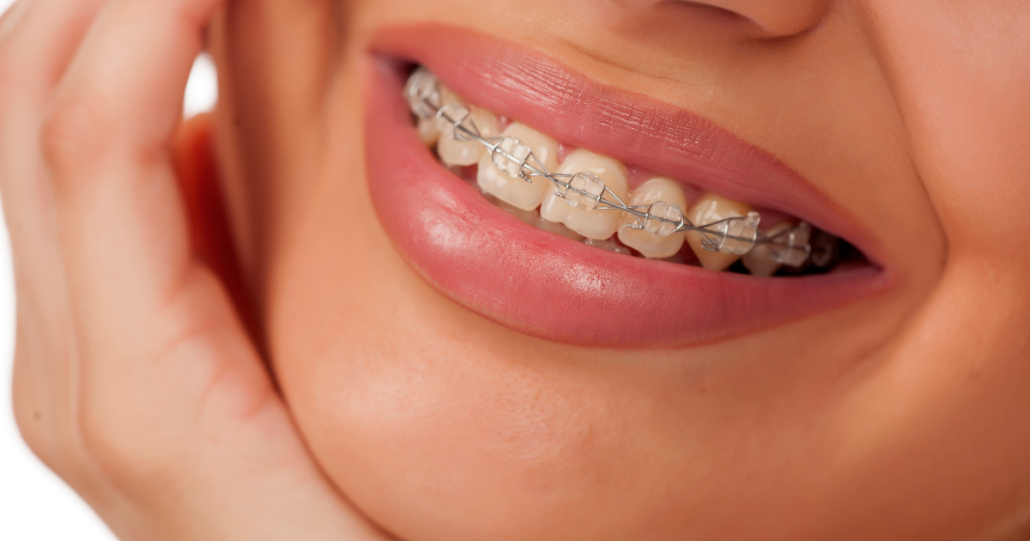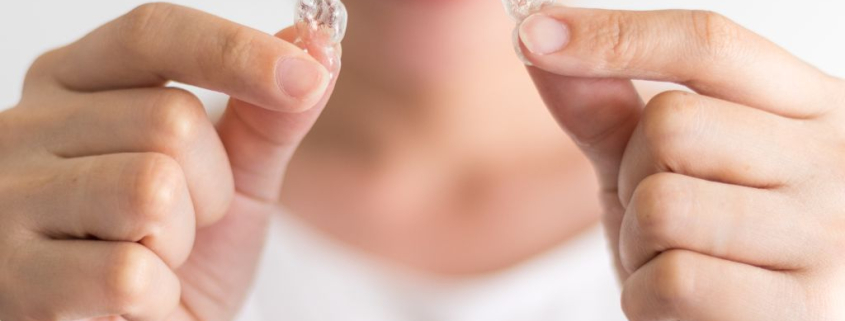Invisalign vs Braces – Costs and Comparisons
You have been thinking about straightening your teeth. There are two popular orthodontic treatments available that are FDA-approved – Metal Braces and Invisalign. Straightening your teeth, restoring your bite, and enhancing your smile are all possible with these devices.
But how do you choose between the two? If you are facing this dilemma, you are in the right place. This article will outline everything you need to know about Invisalign and braces. Read on.
Contents
Overview of Braces and Invisalign
Braces
Braces are appliances used to correct dental and skeletal irregularities. They can either be made of metal or ceramic. Glue is used to attach brackets to the teeth.
Wires connect the brackets and put gentle pressure on your teeth and gums that help them move in the desired manner.
Your orthodontist will prescribe braces for 1- 3 years, depending on the individual circumstances and the severity of the misalignment.
Invisalign
Invisalign was introduced as an alternative form of dental correction. It is a type of orthodontic treatment that uses clear aligners. They are virtually invisible and removable. A set of custom trays are made through impressions created from a 3D model.
Every few weeks, the old trays are swapped for a new set of trays until your teeth eventually get into their final positions.
This treatment may last for a few months to a couple of years. Invisalign is considered adequate for people with mild to moderate misalignment.
Comparison of Braces and Invisalign
Appearance
Invisalign snugly fits your teeth and is transparent. It gives an almost invisible finish. It is especially beneficial for those who feel self-conscious while undergoing treatment for their teeth and is also the main reason it appeals to so many people.
Brackets of traditional braces are now available in ceramic. Ceramic brackets use clear or white-colored brackets, as opposed to the grey/silver brackets used in metallic braces. It gives your braces a more refined look. Although they are less visible than metal braces, they aren’t as discreet as Invisalign.
Comfort
Patients have reported better comfort with Invisalign. Invisalign wearers will experience some discomfort with the new trays. It is natural because the teeth are repositioning. However, since it is wire-free, you will not experience soreness in your cheeks, bruises, etc.
The brackets in a metal brace aren’t sharp but tend to be abrasive. The constant friction with your mouth can result in soreness and bruises. If wires poke out of your brackets, they may cut and bleed you or cause a wound.
It is especially true if you sustain injuries to your mouth or face. The brackets may pierce through the tender tissues of your mouth, tongue, or cheeks.
Treatment time
Whether you opt for Invisalign or braces, how quickly either of the treatments fixes the alignment of your teeth will depend on the severity of crowding, bite issues, and other dental or skeletal problems.
When your orthodontist takes the necessary x-rays and examines your teeth and jaws, they will provide a plan and offer you the essential choices.
Is Invisalign faster than braces? Well, the answer isn’t a simple yes or no. Invisalign could be more efficient since the clear trays fit your teeth snugly. Rather than applying pressure only to the front of the teeth, it applies pressure from all directions. Therefore, Invisalign moves your teeth in multiple directions, while regular braces move them in one direction at a time.
An approximate treatment time is as follows:
Invisalign may take six months to 2 years to complete the treatment cycle. Traditional braces may take 1-3 years.

Cost
Is Invisalign cheaper than braces? Treatment costs vary depending on the region, the orthodontist you consult, and the case’s complexity.
Since Invisalign uses 3D modeling to prepare the aligners and depends on third-party labs created to give each patient a custom fit, the prices may be higher.
When you visit your orthodontist for your first consultation, they will estimate the cost of either treatment. It also plays a crucial role in deciding which option to choose.
If the case involves mild to moderate alignment issues and the treatment time is shorter, it may turn out to be more cost-effective than braces.
Traditional braces cost between $2000 and $9000, while Invisalign costs $3000-$7000. Remember that these prices are only estimates and are subject to change based on several factors.
Maintenance
With Invisalign, users can easily remove the clear trays and brush and floss as they normally would. In the case of traditional braces, you will have to adhere to a specific oral hygiene routine because the brackets are attached to your teeth. It may be lengthy and challenging if you aren’t up for it.
Brace wearers must avoid certain foods like hard and crunchy food, which can damage the braces. Due to their removable nature, Invisalign users are not restricted in what they can eat.
Aligners may allow patients to visit the orthodontist less frequently than braces. The interval between appointments is between 2-3 months. In contrast, braces usually require a visit every four to six weeks.
Effectiveness
Which is more effective, braces or Invisalign? Individual cases will determine which treatment method is most effective.
Invisalign may not always be the best treatment method. Because the success of this treatment heavily depends on the patient’s compliance. For successful treatment, you must wear them for 20-22 hours daily.
Also, it is usually not recommended for mild to moderate orthodontic cases like minor tooth rotations. Braces are great if you have complex orthodontic problems like overcrowding, extensive gaps between teeth, etc.
For brace wearers, however, patients must comply by sticking to their oral hygiene and dental visits. But the compliance isn’t as strict as that of Invisalign wearers.
Advantages of Invisalign
- Discreet appearance: Teenagers and adults prefer Invisalign because it is indistinguishable. They are transparent and fit your teeth snugly.
- Comfort: Invisalign is a removable device with no fixed ligatures or wires. Other than the initial pain of adjusting to the device and the regular discomfort of teeth shifting, you won’t experience pain in the form of tenderness or redness of gums or bruises in your mouth.
- Customizable: These devices are highly customizable and are created out of the latest 3D scanning technology. So, you get specific trays that fit flush against your teeth.
- Better oral hygiene: Maintaining hygiene with Invisalign is pretty straightforward. Remove the trays, brush and floss your teeth, clean your trays, and wear them again or store them in the given case. No elaborate oral hygiene routines are necessary.
- More convenient: They are suitable to wear and use. Dental visits are rare. There are hardly any emergency visits required. Treatment length can be shorter. The aligners are easy to care for. There are no food restrictions during the treatment period.
Advantages of Braces
- Proven effectiveness: Fixed brackets are proven to work because they are permanently bonded to the teeth, so there will be consistent progress. Due to their adhesive nature, glued-on braces are not dependent on patient adherence to wearing them.
- Can treat more complex cases: For complex tooth movements, braces are more appropriate. Braces are an effective method of aligning teeth and correcting bite issues. It can treat minor to more complex issues. Its reliability is time-tested.
- Affordable: It can prove to be more economical. Since the brackets are attached to your teeth, there is no risk of losing the trays.
- Long-lasting results: Your teeth should remain in their new position permanently. A brace’s effects should last a lifetime.
- More options for customization: There are multiple options available in the form of ceramic braces, lingual braces, and so on.

Factors to Consider
- Aesthetics: We have been misled into thinking braces are only for teens. But the fact is, braces are suited for anyone looking to fix their orthodontic problems and have a “straighter” smile.
But as you age, you become more self-conscious, and the thought of having bits of metal sticking out from your mouth may be overwhelming. You might benefit from clear trays, ceramic braces, or lingual braces if that’s you.
- Orthodontic needs: If you are suffering from severe crowding and malocclusion (i.e. the way your upper and lower teeth fit together), then you must opt for metal braces as they are apt for all levels of bite problems. But if you have mild malocclusion, then Invisalign may suit you better.
- Lifestyle: Before getting any orthodontic treatment, you must understand what it entails. It requires following special care and hygiene routines. Discipline and good oral hygiene go hand-in-hand. Some treatment options require more care than others to guarantee the best results.
- Budget: This is another significant factor to consider. Metal braces are the most frugal, followed by ceramic braces and Invisalign.
Frequently Asked Questions
Do orthodontists prefer braces or Invisalign?
Orthodontists recommend treatments that best suit the orthodontic needs of a patient. Before determining the treatment plan, they carefully evaluate each case.
Conclusion
Both Invisalign and braces have their pros and cons. Before deciding on the treatment, you should consider all the particulars discussed in this article. Also, consulting an experienced orthodontist who has treated patients successfully using both mediums will be better suited to help you decide which treatment is the right one for you.
Looking for orthodontic services around Alexandria? We offer child & adult orthodontic, interceptive treatment & braces. Book for an appointment today!
Invisalign vs Braces – Costs and Comparisons




Leave a Reply
Want to join the discussion?Feel free to contribute!